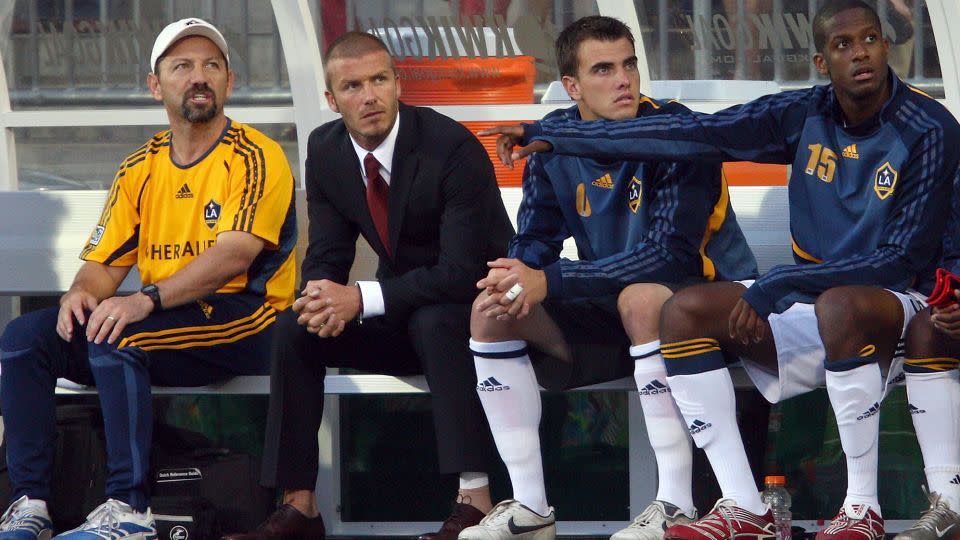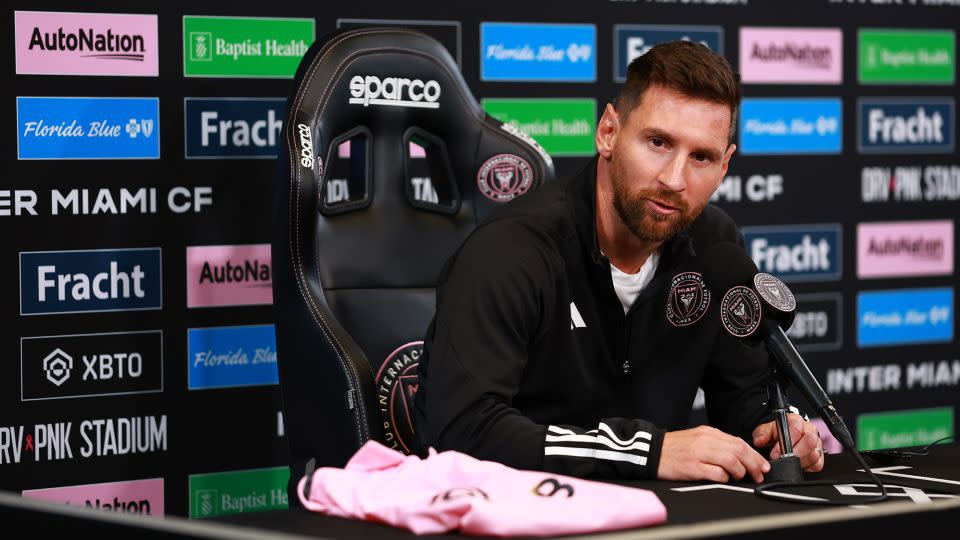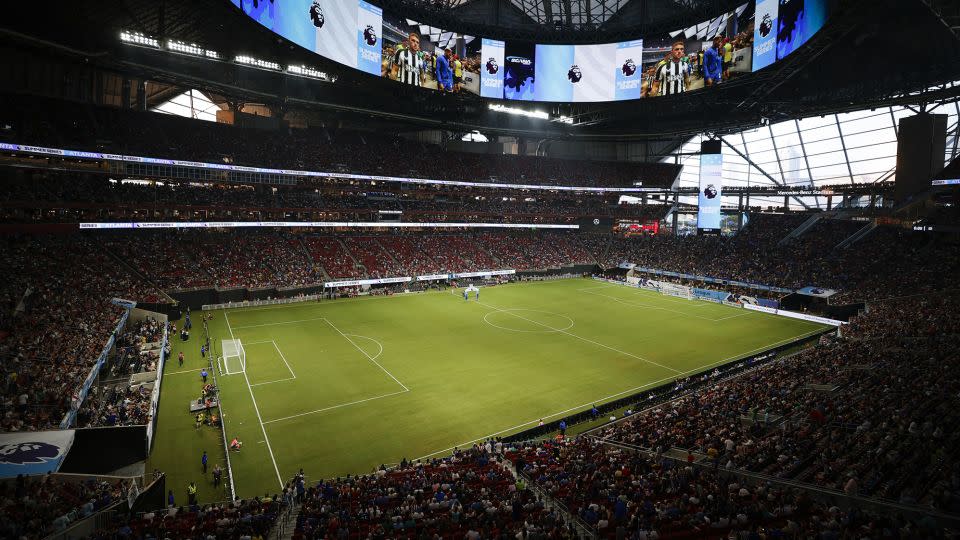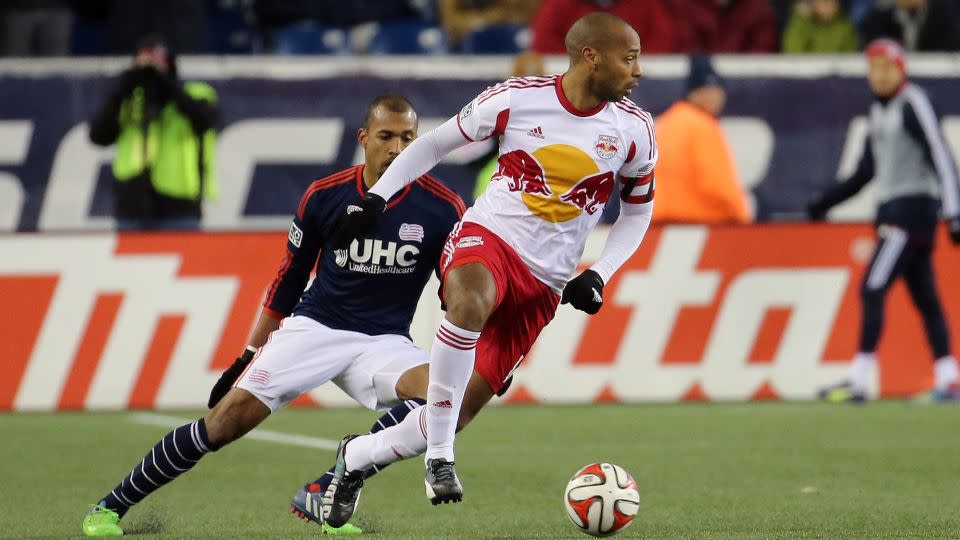Will Lionel Messi play on Atlanta United’s artificial turf?
“Every game, every team should have grass,” said David Beckham shortly after joining Major League Soccer (MLS) in 2007.
Sixteen years on, six MLS teams (over 20%) have artificial turf in their home grounds, including Atlanta United’s Mercedes-Benz Stadium, where Inter Miami will play on Saturday with potentially Lionel Messi featuring.
“As a professional athlete, you can’t play a game like soccer on that sort of field,” said Beckham, who is now the co-owner of Inter Miami, after sitting out a match for LA Galaxy at Toronto’s BMO Field – which had artificial turf at the time – because of an ankle injury.
“What it does to your body as a soccer player, you’re in bits for three days after that,” added Beckham.
At Messi’s introductory media conference after joining Inter Miami, the 36-year-old explained that his “youth was spent on artificial turf, my whole life was on that pitch,” though when he moved to Europe and Barcelona he would play on grass.
“Truth is it’s been a while since I’ve played on artificial turf, but I have no problem adapting myself again,” said Messi.
Nearly all top-level clubs in Europe use natural grass pitches. Bodø/Glimt in Norway and Young Boys in Switzerland are a couple of exceptions, while several clubs in the Netherlands have used artificial surfaces, though the country’s top men’s league, the Eredivisie, announced earlier this year that all games must be played on natural grass from 2025.

Lower leg injuries
In the NFL, Aaron Rodgers’ season-ending Achilles tear on Monday has reignited the debate over whether the game should be played on natural grass or artificial surfaces.
Messi’s arrival to the MLS has also sparked a similar debate in US soccer about the potential health implications of playing on an artificial surface.
The science is conflicting as to whether artificial turf presents increased health concerns to those playing on it.
A study in the Orthopaedic Journal of Sports Medicine released in 2022, which looked at ACL injuries in US high schools from 2007 to 2019, found that among all injuries, ACL injuries were more likely to occur on artificial turf than natural grass in both American football and girls’ soccer. However, no significant association was found in boys’ soccer.
The study also found that among lower-extremity injuries, ACL injuries were more likely to occur on artificial turf than natural grass in both boys’ soccer and girls’ soccer, with no association found in American football.
Meanwhile a study released in 2021 in the Current Orthopaedic Practice found that: “While playing surface generally does not appear to impact overall injury risk in soccer and rugby players, data is inconclusive among American football athletes. Lower-extremity injuries, in particular knee and ankle injuries, more commonly occur on artificial turf in comparison to natural grass.”
Lower leg injuries suffered on artificial turf aren’t just an issue for NFL players. Some women soccer players have expressed their unhappiness about taking to artificial pitches – as well as poorly maintained playing surfaces – and the injury risks that come with it.
“When I was playing as a teenager, we were often playing on 3G pitches and those surfaces are just not ideal for playing football on at all. Some of them were abysmal,” Northern Ireland international Simone Magill – who tore her ACL in the opening game of the 2022 Women’s Euros on a grass pitch – told CNN before this year’s Women’s World Cup.
A 3G pitch is an artificial field made up from rubber crumbs and synthetic grass.

There was controversy surrounding the Women’s World Cup in 2015 with players forced to play on artificial pitches, with some even saying it may have resulted in a lack of goals.
The vast majority of players much prefer playing on real grass, said Magill, with many feeling that injuries are more common on artificial surfaces.
Health risks
Atlanta United’s Mercedes-Benz Stadium opened in 2017. The artificial surface – designed by FieldTurf – is called CORE. FieldTurf said it “is designed to deliver a more realistic, textured, grass-like shape with optimal durability and resiliency.”
Holly Silvers-Granelli, chair of MLS’ medical assessment research committee, explained to CNN Chief Medical Correspondent Dr. Sanjay Gupta ahead of the Women’s World Cup why turf can lead to more lower leg injuries than natural grass.
“So we know the friction coefficient, which is basically the forces between your shoe and the playing surface, are important. So in hockey, there’s very little, you’re sliding on ice for a good reason, you need to glide,” said Silvers-Granelli, who has a masters in physical therapy.
“In soccer or American football or lacrosse or field hockey, we need a certain amount of friction coefficient to perform.
“You need to have a little traction between your foot and the playing surface to change direction, to decelerate, to cut, to make a change based on if the ball is deflected.
“The problem is if that friction coefficient is too high, then that force can be attenuated in the knee and we know that that’s not optimal for the knee.
“The idea is to prepare athletes for any environmental scenario they’ll be in. If you train on grass and your away game is on turf, we don’t want to set you up for a failure.
“So we have to provide biomechanical and strengthening tools to these individuals so that they are not at risk based on any particular Sunday or Saturday that they have an away game.”
CNN has reached out to MLS, Atlanta United and FieldTurf comment.
Artificial pitches tend to be used because of issues with climate and cost-saving, with Silvers-Granelli explaining that there has been an influx in synthetic surfaces in California due to environmental reasons.

Silvers-Granelli also said that a lot of elite athletes had become accustomed to adjusting their games to fit the different playing surfaces, but recommended playing on grass if possible to avoid injuries.
“So when we look at the speed of the game, the way they run, cut, decelerate, they tend to do it a little bit more slowly because they’re intrinsically protecting themselves, which is really fascinating and I think the athletes that are unable to do that could potentially have higher risk.”
Dr. Andrew Pearle, chief of sports medicine at the Hospital for Special Surgery in New York City, echoed Silvers-Granelli’s sentiment.
“I mean, theoretically, on grass, you have a little bit more slide,” he told CNN. “So, you don’t get in these positions … when you tear your ACL, typically your foot or your tibia is stuck, and your body rotates around it. So I think those situations happen more on turf and happen with certain shoes.”
The issue of using artificial turf in NFL stadia and changing it for soccer matches is one raised by Rodgers’ former Green Bay Packers teammate and close friend David Bakhtiari, who published on X, formerly known as Twitter, his displeasure at the practice, saying: “You care more about soccer players than us.
“You plan to remove all artificial turf for the World Cup coming up. So clearly it’s feasible. I’m sick of this..Do better!”
NFL commissioner Roger Goodell told ESPN on Wednesday that he’ll be meeting FIFA President Gianni Infantino next week to discuss the future of playing surfaces.
“They’ll be playing (the) World Cup,” said Goodell, referring to the 2026 tournament, which is being held in North America.
“They will not be putting grass in. They’ll be putting in a mixed grass, mixed grass with artificial surface, something that we’re working to try to see: ‘Is that a better surface for us?’ Because you have to look at climate too,” said Goodell.
“Is the field going to be good in September? Is it also going to be good in December and January?”
French great Thierry Henry, who played for the New York Red Bulls from 2010 to 2014, avoided playing on artificial turf altogether.
“Maybe, I need to remind you,” Henry said in 2011. “Turf is one of the most severe things I’ve seen for us to play on.”

Since moving to the MLS from Paris Saint-Germain, Messi has had a huge impact on the pitch for Inter Miami, as well as off it, notably in generating interest in soccer in the US.
Inter Miami, on a nine-game winless run prior to the 36-year-old’s debut, is now unbeaten in 11 games and captured its first trophy last month.
More than 70,000 fans are expected in Atlanta to watch Atlanta United play Inter Miami, but for his next trick just how will Messi potentially deal with playing on artificial surface?
For more CNN news and newsletters create an account at CNN.com

